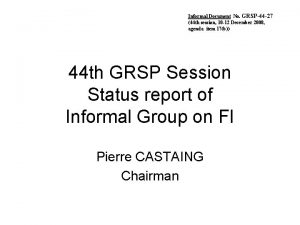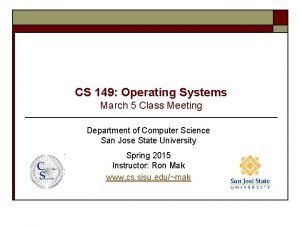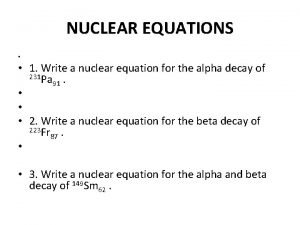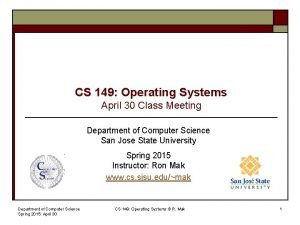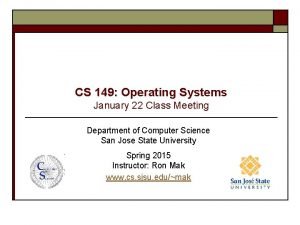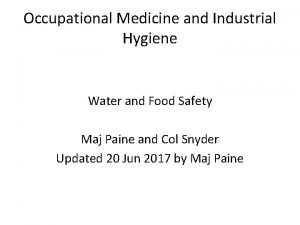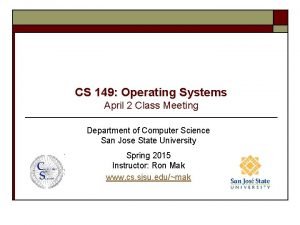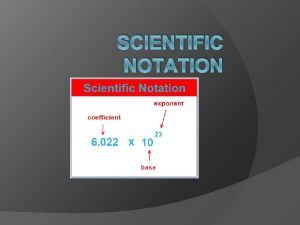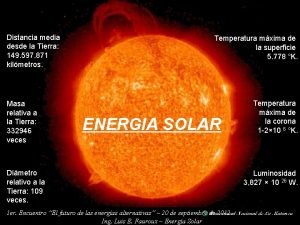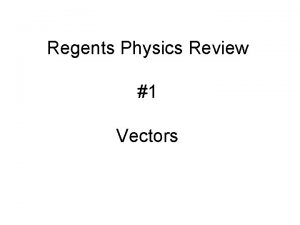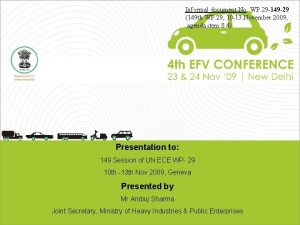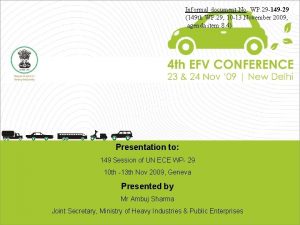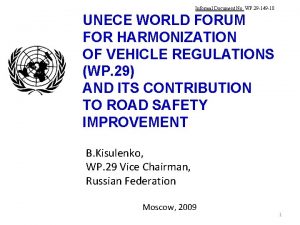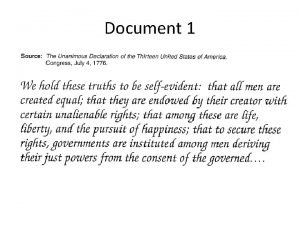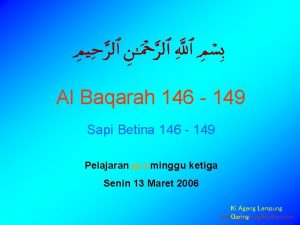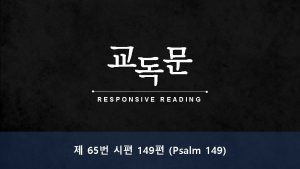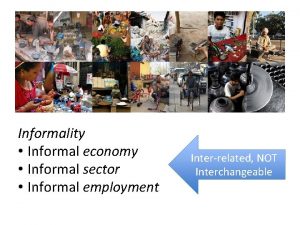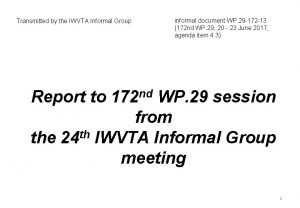Informal document No WP 29 149 11 149













- Slides: 13

Informal document No. WP. 29 -149 -11 (149 th WP. 29, 10 - 13 November 2009, agenda item 4. 3. ) Toward Realization of the “Mutual Recognition of International Whole Vehicle Type Approval (IWVTA)” under the United Nations Proposal for Implementation of Necessary Work for Establishing the Common Bases Transmitted by the representative of JAPAN

Contents 1. Purpose of the Proposal 2. Concept of Mutual Recognition of IWVTA 2 -1 Issues regarding Vehicle regulation and Certification System 2 -2 Benefits of Establishment of Mutual Recognition of IWVTA 2 -3 Concept of a system on Mutual Recognition of IWVTA 3. Plan for future work (provisional draft) 4. Preparation of a Roadmap (provisional draft)

1. Purpose of the Proposal • To aim, in the future, to upgrade the current mutual recognition of approval, which only covers vehicle equipment and parts, to the one that covers a whole vehicle, through realization of mutual recognition of International Whole Vehicle Type Approval (IWVTA) • To establish, keeping in mind this assumed goal, the common bases regarding basic elements necessary for establishing the IWVTA.

2. Concept of Mutual Recognition of IWVTA 2 -1 Issues regarding Vehicle regulation and Certification System Why do we need to discuss the establishment of mutual recognition of IWVTA NOW? Serious safety and environmental problems related to automobiles due to the increasing motorization around the world especially emerging countries : - Environment (global warming, air pollution, etc. ) - Traffic accidents Globalization of economy requires a leaner and more efficient market access Issues Directly Related to Regulations and Certification System The ECE Regulations under the 1958 Agreement do not cover all regulations necessary for whole vehicle type approval. For countries/regions that plan to introduce a vehicle type approval and/or mutual recognition system, there is no universal system which can be based ; therefore, they would need to come up with their own unique system. These issues must be addressed. Economic and Social Issues

2 -2 Benefits of Establishment of Mutual Recognition of IWVTA If the mutual recognition of vehicle type approval (including all technical requirements on a whole vehicle) is established under the UN, (1) Benefits from harmonizing regulations, while maintaining road safety and environmental protection, will increase, further promoting Contracting Parties’ activities for harmonizing regulations related to vehicle construction and equipment, etc. (2) It will serve as a model system that would help the aligned vehicle type approval system to be established around the world and accelerate the activities for realization of mutual recognition system based on the type approval. Government (G) Industry (I) Through harmonization, advance safety and environmental regulations will be implemented internationally. Testing and approval procedures will be streamlined. Establishment of vehicle type approval system in developing countries, etc. will be facilitated. *Be n bot eficia h. G l fo a *Sh nd r oul I. db rea e l G-I ized t h col lab rough ora tion. Costs and man-hours required by differing development and certification procedures for complying with regulations of each product destination will be reduced. Resource can be spared for development of improved safety and environmental technologies. User Wider availability of safer, more environmentallyfriendly vehicles with reasonable prices Realization of sustainable mobility society

2 -3 Concept of Mutual Recognition of IWVTA (1) Basic Ideas To establish, in the future, “a system concerning mutual recognition of IWVTA” under WP. 29 through utilization of “the agreement on mutual recognition of approval for motor vehicle equipment and parts” To establish a system concerning mutual recognition of IWVTA in the framework of the UN agreement, based on the existing agreement concerning mutual recognition of approval for motor vehicle equipment and parts. The IWVTA system to cover procedures up to the issuance of certificates of conformity related to a whole vehicle; the registration of vehicles in each country based on those certificates of conformity to be carried out pursuant to its national legislation (ref. EU-WVTA). The system to be implemented for passenger cars primarily. Composition This system consists of the following two parts: Part on IWVTA procedure Part on mutual recognition of approvals among Contracting Parties

2 -3 Concept of a system on Mutual Recognition of IWVTA (2) Contracting Party (CP) System on Mutual Recognition of IWVTA (Image) Constituent of IWVTA procedure Vehicle registration Approval of construction/equipment Quality control * Initial Assessment for applicant * COP Certificate of Conformity Whole vehicle type approval application Testing of Whole vehicle’s conformity with technical requirements Process for rule making Duty of CP accepting type approval Duty of CP issuing type approval Qualification of technical service Obligations of applicant Designation of technical service : Covered by the current the 1958 Agreement Safe guard clauses (refusal) Information for registration Constituent of Mutual Recognition Recall provisions … and more : Modified for the new mutual recognition system : Covered by the current the 1958 Agreement but partially need to be amended : Newly added

3. Plan for future work (provisional draft) (1) Development of elements necessary for IWVTA (1 st step) As the 1 st step, those with high priority for consideration among elements for the IWVTA system will be developed as the common bases. (1) Elements with high priority for consideration a) Requirements necessary for specifying vehicles (definitions of types, dimensions, masses, etc. ) b) Issues identified regarding management of the mutual recognition of approval for vehicle equipment and parts under the 1958 Agreement, etc. (interpretation issue, etc. ) c) Regulatory items that could facilitate the mutual recognition of approval for vehicle equipment and parts under the 1958 Agreement (technical requirements necessary for IWVTA, etc. ) (2) Reflection to the 1958 Agreement If elements that are judged to be appropriate to be reflected to the existing the 1958 Agreement through this consideration are identified, such elements will be reflected immediately. (2) Consideration of the 2 nd step If, based on the consideration at 1 st step, it is judged that the activity should continue, as the 2 nd step, to further consider elements necessary for mutual recognition among Contracting Parties such consideration will be carried out.

3. Plan for future work (Image 1) System on Mutual Recognition of IWVTA (Image) Contracting Party (CP) Constituent of IWVTA procedure Vehicle registration Approval of construction/equipment Quality control * Initial Assessment for applicant * COP Certificate of Conformity Whole vehicle type approval application Testing of Whole vehicle’s conformity with technical requirements Process for rule making Duty of CP accepting type approval Duty of CP issuing type approval Qualification of technical service Obligations of applicant Designation of technical service : Covered by the current the 1958 Agreement Safe guard clauses (refusal) Recall provisions … and more : Modified for the new mutual recognition system : Covered by the current the 1958 Agreement but partially need to be amended To be considered at 1 st step (-2016) Information for registration Constituent of Mutual Recognition : Newly added To be considered at 2 nd step (2016 -)

3. Plan for future work (Image 2) Constituent of IWVTA Development of elements procedure necessary for IWVTA (1 st step) Whole vehicle type approval application Testing of Whole vehicle’s conformity with technical requirements Approval of construction /equipment Quality control * Initial Assessment for applicant * COP The following elements will be developed as common bases while utilizing the 1958 Agreement: 1. Scope under this system (passenger cars; treatment of M 1 category) 2. Information necessary for specifying applicants’ vehicles (1) Definitions of vehicle types (2) Definitions of categories, dimensions, masses (3) Other vehicle specifications 3. Application documents 4. Treatment of procedures for modification (discussions on revision, extension, etc. being held at GRSG) 5. Technical requirements necessary for IWVTA to be developed as regulatory items under the 1958 Agreement 6. Regulatory interpretation issue (WP. 29/1059) Already covered by the 1958 Agreement and can be extended and applied to IWVTA

4. Preparation of a Roadmap (provisional draft) - Proposal of establishment informal group 4 -1 Output from the 1 st Year of the 1 st Step Informal group established based on a proposal at WP 29 in March 2010 would identify elements to be considered and develop its roadmap. 1 st year: A roadmap showing the discussion schedule for each element to be considered will be developed; the agreed roadmap will be submitted to WP. 29 in March 2011. 2 nd year and thereafter: Whether the Informal Group should continue to exist will be determined based on the output from the 1 st year. Image of Elements 1. Scope under this system (passenger cars; treatment of M 1 category) 2. Information necessary for specifying applicants’ vehicles (1) Definitions of vehicle types (2) Definitions of categories, dimensions, masses (3) Other vehicle specifications 3. Application documents 4. Treatment of procedures for modification (discussions on revision, extension, etc. being held at GRSG) 5. Technical requirements necessary for IWVTA to be developed as regulatory items under the 1958 Agreement 6. Regulatory interpretation issue (WP. 29/1059)

4 -2 Image of Roadmap in the 1 st Step until March 2016 2009 2010 2011 2012 2013 2014 2015 2016 Roadmap Informal Doc. approved by WP. 29 submitted Proposals to WP. 29 according to the roadmap Proposal to WP. 29 Adopted by WP. 29 Inf Gr (to be continued as necessary) Roadmap developed Elements considered Image of Elements 1. Scope under this system (passenger cars; treatment of M 1 category) 2. Information necessary for specifying applicants’ vehicles Adopted by GR (1) Definitions of vehicle types (2) Definitions of categories, dimensions, masses (3) Other vehicle specifications 3. Application documents 4. Treatment of procedures for modification (discussions on revision, extension, etc. being held at GRSG) 5. Technical requirements necessary for IWVTA to be developed as regulatory items under the 1958 Agreement 6. Regulatory interpretation issue (WP. 29/1059) Discussed at GRs Regulations under the 1958 Agreement to be amended Organization for promoting this project (establishment of Informal Group) to be proposed to WP. 29 in March 2010: Work items: * Development of the overall roadmap * Consideration of elements 1 -6


